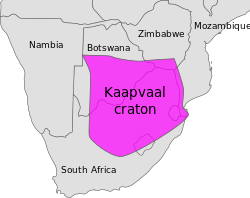- By John Eagles
- In geology, a supercontinent is the assembly of most or all of the Earth's continental blocks or cratons to form a single large landmass. The definition of a supercontinent can be ambiguous. Sometimes a clustering of nearly all continents is meant, sometimes a supercontinent is also seen as one of two big continents that existed simultaneously.
- Supercontinents have assembled and dispersed multiple times in the past.
- The causes of supercontinent assembly and dispersal are thought to be driven by processes in the mantle. Approximately 660 km into the mantle, a discontinuity occurs, affecting the surface crust through processes like plumes and "superplumes".[1]
First supercontinent Vaalbara 3.1 billion BP
- Vaalbara is Earth's theorized first supercontinent. There is some dispute as to Vaalbara's supremacy as the oldest supercontinent as the Australian continent also contains remnants of Ur. Vaalbara is understood to have been a complete supercontinent by 3.1 billion years ago. Vaalbara possibly formed beginning 3.6 billion years ago and was broken apart by about 2.8 billion years ago.
- Vaalbara is Earth's theorized first supercontinent. There is some dispute as to Vaalbara's supremacy as the oldest supercontinent as the Australian continent also contains remnants of Ur. Vaalbara is understood to have been a complete supercontinent by 3.1 billion years ago. Vaalbara possibly formed beginning 3.6 billion years ago and was broken apart by about 2.8 billion years ago.
References
- ↑ A mantle plume is an upwelling of abnormally hot rock within the Earth's mantle.


